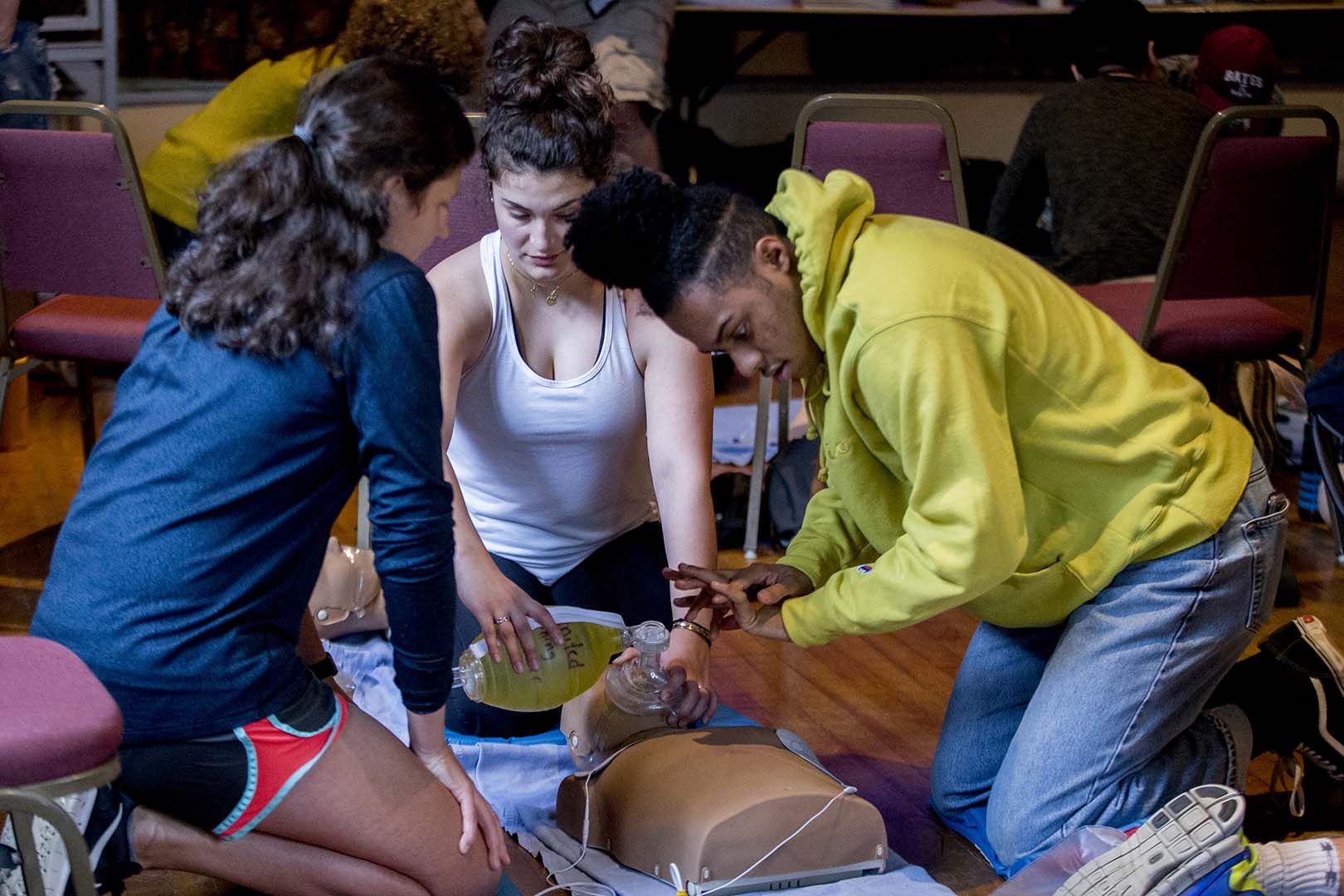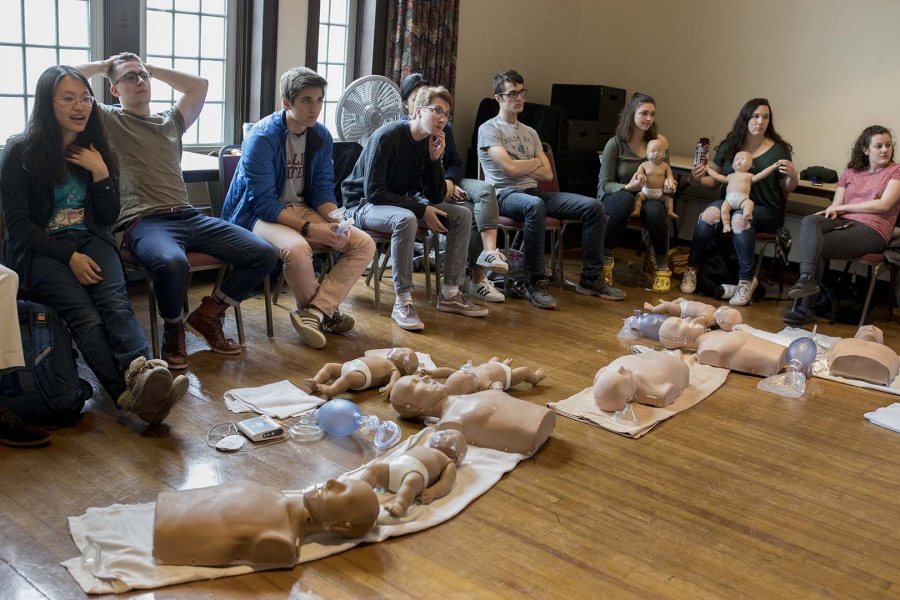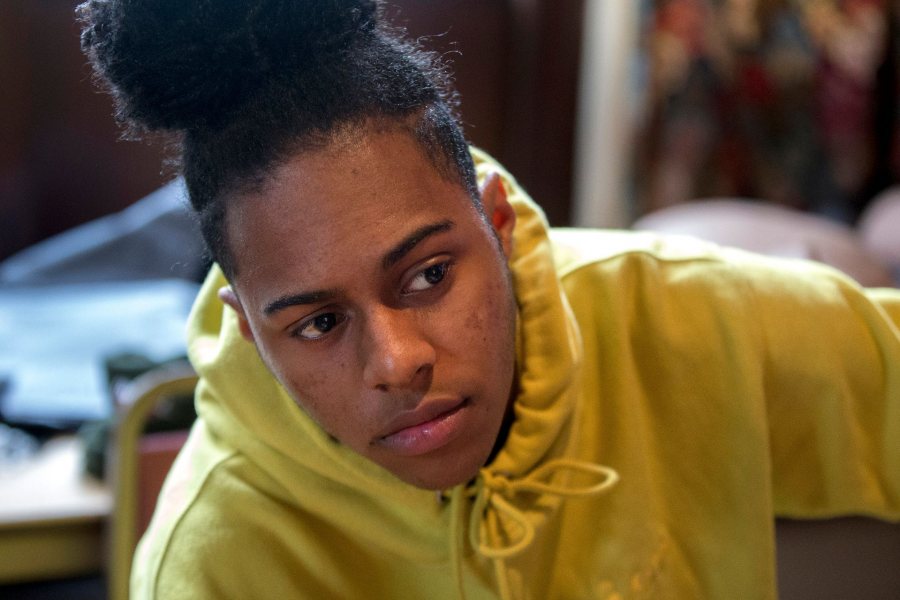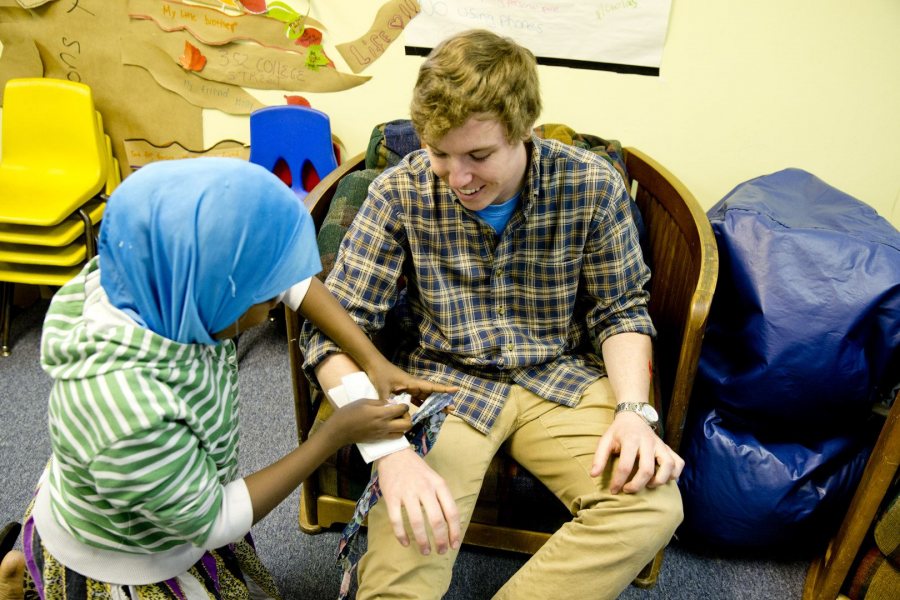On a recent Monday afternoon, some three dozen Bates students convened in Chase Hall’s Hirasawa Lounge to practice the CPR skills they’d learned that morning.
On a cue from Michael Dube, the instructor of the Emergency Medical Technician certification course, the students broke into small groups and gave 10 minutes of chest compressions and rescue breaths to dummies. Lights embedded in the dummies’ shoulders indicated whether they were applying enough pressure.
By completing the intensive course (40 hours a week over five weeks), the newly minted EMTs can join ambulance or first-responder teams in many places — including right on campus, with the Bates Emergency Medical Services.
BEMS volunteers are the first responders for any call for medical help that comes to Bates Security and Campus Safety, whether it’s a student with a sudden illness or a staff member who falls during an ice storm.

During a Short Term EMT training course, Robert Winckler ’21 (right) practices chest compressions on a dummy, while Mackenzie Winslow ’19 (center) gives rescue breaths and Bella Stone ’19 waits to rotate in. (Phyllis Graber Jensen/Bates College)
At all times of the day and night during the school year, at least three volunteers carry radios and essential medical supplies everywhere they go, ready to leave class, Commons, or their beds at a moment’s notice to get to a scene.
A dedicated cohort of 40 students, the Bates EMTs can do everything from CPR to splinting bones to placing patients on backboards. They’re responsible for assessing a scene, providing some treatment, and, if necessary, helping transfer patients to an ambulance.
“They’re first responders for their peers, and we trust them,” said Senior Associate Dean of Students Erin Foster Zsiga, who oversees the student EMTs. “It’s a big job, a big responsibility, and really important work for the institution.”
A student board, headed by a chief and deputy chief, takes the lead in managing day-to-day operations such as scheduling and inventory, as well as policy development and recruitment.
Meanwhile, Foster Zsiga is there for support and guidance as needed. Working in tandem with BEMS leaders, she’s helped the organization secure funding and provide scholarships to a certification course. The college has also partnered with United Ambulance (where EMS course instructor Michael Dube is clinical coordinator) for additional quality control, including a consulting paramedic, and a range of training opportunities.
“We are taking what BEMS has already done, which was student-led, and provided the supplemental support of Student Affairs,” Foster Zsiga said. “There’s someone here who can help when they need help and answer questions.”
The student EMTs’ work is a valuable safeguard for the well-being of Bates students, faculty, and staff on campus. It’s also a defining experience for the students. Often aspiring health professionals, they get a hands-on introduction to the world of medicine that’s valuable when applying to graduate programs.
Miles Lamberson ’19 of Hinesburg, Vt., who will be the BEMS chief of service next year, said he’s gotten calls while studying in the library, eating at Commons, and in the middle of the night before a big test. “I wouldn’t trade it for anything else,” he said. “I’ve learned so much from my fellow line officers, BEMS members, and patients alike about myself, medicine, and people.”
Student EMTs are on call for 12 or 24 hours at a time. In practice, emergency calls are sporadic, said Jillian Sheltra ’19 of Biddeford, Maine, who will be the deputy chief of service next year. BEMS can go weeks without a call, or get several on the day of a big event.
As with a student EMS program at any college, the nature of the call “depends on what’s happening on campus,” Sheltra said. “We see seizures pretty frequently and general illness things like the flu. We also respond to some traumas like sports injuries for club or intramural teams. We go to our fair share of intoxication-related calls.
“It’s kind of a mixed bag, everything from a chest pain call to, ‘I fell and stubbed my toe.’ You never know what you’re going to get.”

Jillian Sheltra ’19 of Biddeford, Maine, will be the Bates EMS deputy chief of service in 2018–19. (Theophil Syslo/Bates College)
When a call comes in (all calls also summon a United ambulance), the EMTs drop what they’re doing and go to the scene, either on foot or in a Toyota Highlander, affectionately named Heidi, that carries more equipment. They figure out what’s going on, provide necessary treatment, and decide whether to call off the ambulance.
Because of the wide range of possible emergencies, responders have to know a wide range of treatments. A basic EMT certification is required of all BEMS volunteers, many of whom earn it through the Short Term course.
After the 10 minutes of CPR practice, Dube, the United instructor, reminded the EMT hopefuls that the real world would be quite different from the controlled setting of the Hirasawa Lounge.

Students in the Short Term EMT certification course, offered by Bates and United Ambulance, listen to instructions before practicing CPR on dummies. (Phyllis Graber Jensen/Bates College)
The reminder struck home for Mackenzie Winslow ’19, working in a group with Bella Stone ’19 and Robert Winckler ’21. They quickly realized how strenuous giving chest compressions is. When an instructor announced they’d been going for three minutes, “we looked at each other and said it feels like it’s been forever,” Winslow said.
Winslow is a neuroscience major, Winckler is inclining toward the field, and Stone is a biology major. All three plan to go into healthcare careers, and all are interested in joining BEMS after they get certified.
“This is such a great way to learn different skills and get ahead in the field itself before we all start going to med school, PA school, vet school, wherever we’re headed,” Winslow said. “This is a great way to start practicing for the real world.”
The skills student EMTs learn at Bates reverberate beyond the campus.
Providing emergency medical care requires more than knowing certain procedures. EMTs have to be a calming presence in chaotic situations and, especially in a small community like Bates, maintain professionalism, whether they’re on call or not.

Robert Winckler ’21, who’s looking at majoring in neuroscience, is getting a basic EMT certification this Short Term. The opportunity to get hands-on experience in healthcare drew him to the course. “It’s a great summer job,” he said. “It’s also a good test to see if you can go into the medical field.” (Phyllis Graber Jensen/Bates College)
“You definitely have to be tactful,” Sheltra said. “You’re going to see people who had an emergency, and you’ll see them in Commons the next day. We take a lot of pride in our role, which comes across as respecting people’s privacy and being there when they need us.”
The skills student EMTs learn at Bates reverberate beyond the campus. Many use their certifications to get summer jobs on ambulances in their hometowns, or further their education with an intermediate EMT or even a paramedic certification.
They can also parlay their experiences into a spot at a medical school or other graduate program in healthcare.
Billy Curley ’16, who was integral to strengthening the ties between BEMS and the college, is attending Harvard Medical School. Andrew Lachance ’17, last year’s chief of service, and Katie Stevenson ’17, the deputy chief, were also closely involved with increasing Student Affairs’ guidance and support in 2017; both will attend Tufts University School of Medicine in the fall.
Lachance, who is now a researcher at the National Institutes of Health in Baltimore, is looking to return to Maine as a surgeon or cardiologist. He said he could always find former Bates EMTs attending the medical schools that interviewed him for admission, and the schools were impressed not only with his experience in the field but with his understanding of logistics, scheduling, documentation, and communications.

During his senior year, Billy Curley ’16 works with a participant in a session of the “How Everything Works” program at the Hillview Community Resource Center in Lewiston. A Bates EMS leader as a student, he’s now at Harvard Medical School. (Phyllis Graber Jensen/BAtes College)
“You know you have the capabilities to work well under pressure and in teams, communicating with patients when they’re at some of their worst moments,” LaChance said. “You can give examples of calming down a patient, giving them mental health resources they need, or splinting a fracture. It’s such valuable real-world experience that’s important for someone going into the medical field, but it’s also translatable to business or politics or anything else.”
“It takes a strong person, but it’s super rewarding.”
Sheltra, who earned a two-year paramedic certification in addition to her Bates courses, also plans to go to medical school — and because she was an EMT at Bates and elsewhere, her interests have shifted from surgery to emergency medicine. The day-to-day work of helping people in need has defined her experience, she said.
“Someone’s calling you because they’re probably having one of their worst days, and for you to not make that your worst day too, and then to get up and go to work the next day — it takes a strong person, but it’s also super rewarding,” Sheltra said.
“We respond to these times that people are having where they’re sad or they’re hurt or they’re sick, and to be able to fix that and make it a little bit better for them is ideal.”




